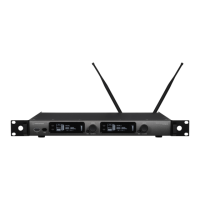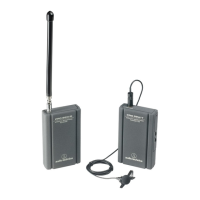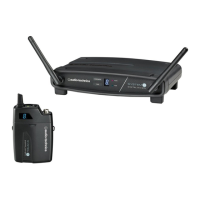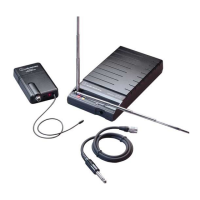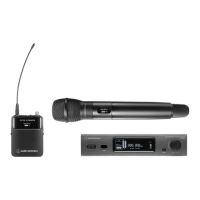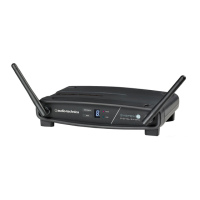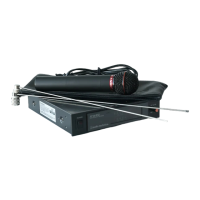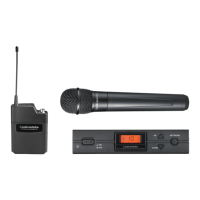10
System Operation
Switch on the receiver. Do
not
switch on the transmitter yet.
Selecting/Setting Frequency
Selection of the desired operating frequency is made through the function menus. It’s
usually best to start by setting the receiver’s frequency, to determine there is no local
interference on that frequency. Then, always make certain to set the transmitter to the
receiver’s
exact
frequency. The receiver’s unique Digital Tone Lock system squelches
the audio only, permitting any RF energy on the frequency to show on the “RF” bar-
meter.
Receiver On
The Alert indicator and the LCD window will light up; the normal-operation LCD display
will appear after 1-2 seconds (Fig. D-1). If any of the bars show in the
“RF”
bar-graph
meter, there may be RF interference in the area. If this occurs, select another
frequency as explained below. (If the Meter Hold function has been selected, one of
the RF bars will be flashing, indicating the lowest RF level received.)
E Band Frequency Scan Group Selection
To select frequency Scan Group G1, G2 or G3 (example page 16). With the power off,
Press and hold upper arrow key while powering on. Select the required Frequency
Scan Group G1, G2 or G3 by pressing the "Mode/Set Button" until the desired group
appears in the display.To store the selected frequency Scan Group, press the power
switch to turn the receiver OFF, then press the power switch to turn the power on.
Using the Automatic Scan Function to Set Receiver Frequency
Automatically
1. Press the Mode/Set button once; then the “
RF
” and “
AF
” scales will
disappear from the window and only the frequency will appear in the LCD
window. (The receiver is now in the Menu mode.) See Figure D-2.
2. Use the Up arrow button to reach Scan 1, Scan 2, or Scan 3. Press the Mode/Set
button once to select one of these three Scan groups. The lowest frequency in
the selected Scan group will appear in the LCD window.
3. Press the Up or Down arrow button to begin the scan. The word
“SCAN1”,
“SCAN2”
or
“SCAN3”
will flash in the LCD window, depending on which Scan
group you selected in step 2.
* Select then press the up arrow button to scan start from bottom or Down arrow
button to start from Top.
4. The first available frequency will flash in the LCD window. To activate this
frequency selection,
press and hold
the Mode/Set button until the word
“STORED”
appears in the LCD window. (If you do not wish to complete this
particular selection, just press the Mode/Set button once. The word
“ESCAPE”
will appear briefly in the window and the receiver will return to the Menu mode.)
5. After you have activated your frequency selection (step 4), the
“RF”
and
“AF”
scales will reappear in the window, indicating the return to normal operation.
6. If you are using multiple systems, after completing the first receiver's scan and
frequency selection, set the transmitter to the same frequency (see
Setting
Transmitter Frequency
instructions on page 11); leave the transmitter
On
, and
run the next receiver’s automatic scan function. Always set a receiver-transmitter
pair to the same frequency before using the automatic scan function to select a
frequency for the next receiver.
* Note: Make certain that prior to powering on the matched transmitter, press and hold
the R3100 Mode/Set button to store the frequency selected, otherwise the receiver will
re-scan to find another Open/Clear frequency.
See illustration figures
Transmitter Setup
Battery Selection and Installation
Each transmitter uses two 1.5V AA batteries, not included. Alkaline type is
recommended. Always replace both batteries.
Make certain the transmitter power is
Off before replacing batteries.
UniPak™ Transmitter Battery Installation
1. Open the battery compartment door by sliding the catch down (Fig. K). (If no
batteries are inside, the door will not spring open by itself.)
2.
Observe correct polarity as marked on the metal contacts on the door
and
carefully insert two fresh 1.5V AA alkaline batteries (Fig. L).
3. Close the door, making certain the latch clicks securely in place.
Handheld Transmitter Battery Installation
1. While holding the lower body cover (near the LCD window), grasp the upper part
of the transmitter body just
below
the grille and unscrew it at least four complete
turns (Fig. G); then slide the lower body cover down until it stops (Fig. H). Once the
cover has been lowered, turn the transmitter over to reveal the battery
compartment on the side opposite the LCD window.
2.
Observe correct polarity as marked inside the battery compartment
and car
fully insert two fresh 1.5V AA alkaline batteries (Fig. M). Insert the first battery and
slide it down. Then insert the second battery, bottom first, into the space
remaining. Make certain the batteries are fully seated in the battery compartment.
3. Slide the lower body cover back up the body, then screw the housing together.
Do
not overtighten.
Note: Remove batteries from the handheld transmitter starting at the
bottom
(– end) of
the top battery (Fig. M). The top (+ end) of the top battery is captured in a recess and
will not come straight out.
Battery Condition Indicator
After the batteries are installed, turn the power on by
pressing and holding
the
Power/Mute button. The small red power-on LED (Fig. E/F) should light and the LCD
window should come on. If this does not happen, the batteries are installed incorrectly
or they are dead. The transmitter’s “fuel gauge” battery indicator displays a maximum of
four bar segments. When it flashes
“LOW.BAT”
, the batteries should be replaced
immediately to ensure continued operation. (The receiver also displays transmitter
battery condition in the LCD window with bar segments; the Alert indicator comes on to
warn of a low-battery condition.)
UniPak Transmitter Input Connection
Connect an audio input device (microphone or guitar cable) to the audio input jack on
the top of the transmitter. A number of Audio-Technica professional microphones and
cables are available separately, pre-terminated with a UniPak input connector (see
“Optional System Accessories” on page 13). The cable connector latches automatically
when inserted into the transmitter jack. To unlatch and remove the connector, simply
pull up on the connector’s knurled metal collar.
UniPak Transmitter Antenna
The UniPak transmitter includes a field-replaceable flexible antenna. For best results,
allow the antenna to hang freely and full length from the top of the transmitter. If the
received signal is marginal, experiment with different transmitter positions on your body
or instrument; or try repositioning the receiver or using remote receiver antennas. Since
the transmitter antenna simply screws in, check it occasionally to make certain it is
snugly attached (finger-tight).
Do not change the length of the transmitting antenna.
Handheld Transmitter Antenna
The antenna for the handheld mic/transmitter is in the black, non-metallic section at the
bottom of the unit (Fig. F). For best results, hold the mic/transmitter naturally, around its
painted metal case; holding or otherwise covering the antenna housing may affect
operating range.
UniPak Transmitter Mounting Clip
The UniPak transmitter’s mounting clip may be installed with the case positioned either
“up” or “down,” depending upon which is preferred for the application. To turn the clip
around, spring the ends of the clip out of the two holes on the sides of the transmitter
case (Fig. E) and reinstall it facing in the opposite direction.
E
N
3000 Series OM (Nov.08).qxd:12MAY3000OM.qxd 26/11/08 16:15 Page 10
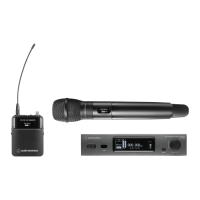
